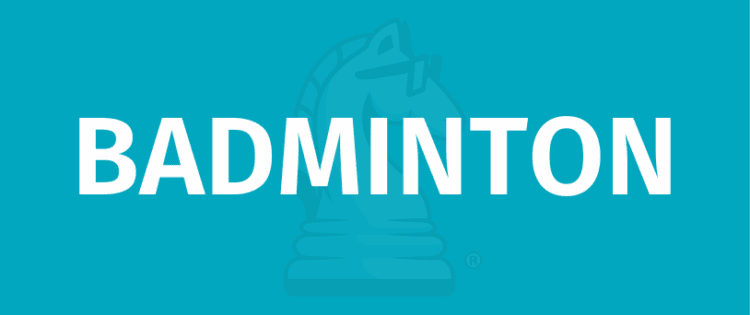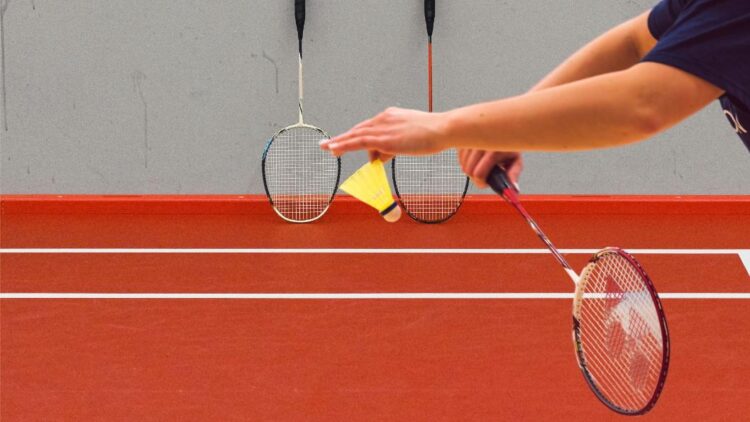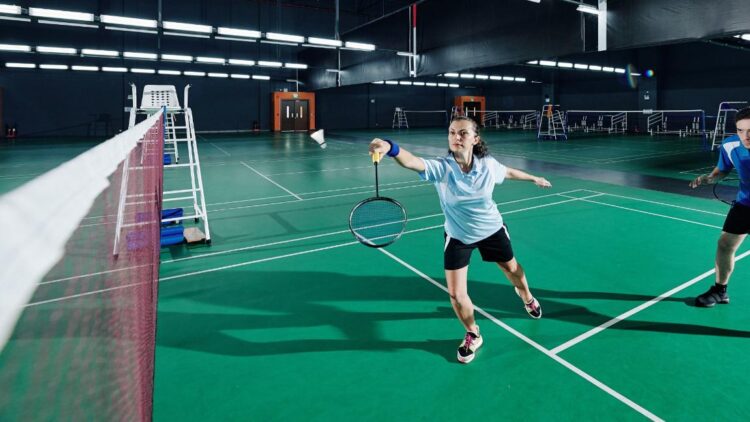
OBJECTIVE OF BADMINTON: Be the first team to reach 21 points by hitting the shuttlecock over the net and preventing the other team from returning it.
NUMBER OF PLAYERS: 2 or 4 players, 1 or 2 on each team
MATERIALS: 1 badminton racket per player, 1 shuttlecock, 1 badminton net
TYPE OF GAME: Sport
AUDIENCE: All ages
OVERVIEW OF BADMINTON

Badminton is a sport with a long history. It first originated in Asia over 2,000 years ago, but the sport didn’t gain widespread prominence until British military officers brought it to England in the mid-1800s. The sport was originally called “battledore,” and its name has changed to “badminton” over the years, but the use of the shuttlecock instead of a traditional ball has remained a constant.
Like most other racket sports, such as tennis, badminton in England was mostly played by the upper classes. Interestingly, it was a simple competition where players would hit the shuttle back and forth as many times as they could.
The newer rules that most resemble modern badminton only emerged in 1893. After the sport soon spread to Canada, badminton also made its way to the United States in 1929. Badminton became an Olympic sport in 1992, cementing its importance in sports.
While badminton is popular all over the world, this sport is especially popular in Asian countries, notably China and India, which produce some of the best badminton players in the world!
Badminton, as we know it today, is a sport played in either singles (1 vs 1) or doubles (2 vs 2). The goal of badminton is to hit the shuttlecock (which is a small, lightweight cone used as the “ball”) over the net to the opponent’s side of the court before it hits the ground on your side. This exciting sport tests athletic stamina as well as hand-eye coordination skills and agility.
SETUP FOR BADMINTON

Here’s a look at what you need to set up a badminton match.
COURT
A badminton court measures 44 feet by 16.7 feet in singles or 44 feet by 20 feet in doubles. The court is split in half by the net, which measures about 5 feet tall. Each half of a badminton court is divided into the right and left service courts, with a center line marking the divide. There is also a sideline that marks the out-of-bounds area, a separate sideline for doubles, and a back boundary line.
You’ll also find two types of service lines in a badminton court: the short service line and the long service line.
BADMINTON EQUIPMENT
You’ll also need the right equipment to play a proper match of badminton. Of course, first things first, you’ll need a badminton racket per player and a shuttlecock to hit back and forth. Ideally, you should have more than one shuttlecock at hand.
There’s no official badminton uniform – just wear whatever is most comfortable for you! For most players, that will generally be a moisture-wicking t-shirt and shorts, as well as sturdy tennis shoes with good traction.
f you are looking to purchase a new badminton set, we recommend checking out the Franklin Sports Badminton Set.
HOW TO PLAY BADMINTON: ALL THE RULES
The badminton match starts with a coin toss. The winner of the coin toss can decide whether to serve or receive first. Players will hit the shuttlecock (also called a birdie) back and forth until one player hits it out of bounds or cannot hit the shuttlecock back over the net before it hits the ground.
BADMINTON SERVICE RULES

The server must stand within the service court while serving. The serve must clear the net and cross the court diagonally to the receiver’s service court past the short service line. In order to serve legally, the server must keep both feet on the ground and hit the shuttlecock from below the waist.
The server and the receiver should stay in the designated service court until the shuttlecock has been served. If the serve lands anywhere outside of the correct service court during the serve, the opponent gets a point.
RIGHT OR LEFT SERVICE COURT
The server must serve from the right service court if their own score is an even number and from the left service court if their score is odd.
HITTING THE NET
Unlike ping pong, if the shuttlecock hits the net but still goes over to the opponent’s service court, it is a valid serve. However, if the shuttlecock hits the net and doesn’t make it over to the other side or falls short, the opponent gets a point and serves.
SERVICE COURT ERROR
When a player serves out of turn, serves from the wrong service, or stands on the wrong service court, this is a service court error. You can only enforce a service court error if it is discovered before the next serve. Here are the rules if a service court error is discovered:
- If both sides committed a service court error, it is a “let.”
- If the player who committed a service court error won the rally, it is a “let.”
- If the player who committed a service court error lost the rally, there is no error.
SERVING RULES FOR BADMINTON DOUBLES

The service court boundary is slightly larger in doubles. The non-serving and non-receiving players on each team may stand anywhere on the court as long as they are not in the way of the server or receiver. The designated server continues to serve for their team until the opposing team gets a point. The players on the serving team should swap positions after each serve because the server will need to switch between the left and right service courts after each point.
RALLY
After the serve, the players hit the shuttlecock back and forth over the net until one player faults or fails to return the shuttlecock. The rally can go on for as long as the players continue to hit the shuttlecock legally within the appropriate boundary lines.
The shuttlecock cannot hit the ground, and players cannot hit the shuttlecock more than once in a row.
HITTING THE NET
A player or their racket is not allowed to touch the net, but if the shuttlecock hits the net and goes over to the other side, it is still in play.
SCORING
Badminton rules state that a player wins a point if they win a serve or if the other team faults. When a player wins a point, they serve for the next point, and they continue serving until the opposing team wins a point.
LETS
The umpire or a player (if there is no umpire) can call a let to halt play. When a let occurs, the play since the last serve does not count, and the player who served serves again. You can call a let in the following situations:
- The shuttlecock is caught in the net, except on service
- Both the server and receiver fault at the same time during service
- The server serves before the receiver is ready
- The shuttlecock disintegrates during play
- A line judge’s view is obstructed, and the umpire can’t make a decision
- A service court error
FAULTS

Here is a list of faults that will result in losing a point to the other team:
SERVICE FAULTS
- Serving from above the waist
- Lifting a foot off the ground during a serve
- Moving feet before the serve
- Delaying the serve or service motion
- Missing the shuttlecock when serving
RECEIVER FAULTS
- Moving before the serve
- (In doubles) The receiver’s partner returns the shuttlecock
RALLY FAULTS
- The shuttlecock is out
- The shuttlecock passes through or under the net
- The shuttlecock doesn’t pass the net
- The shuttlecock touches the side walls or ceiling
- The shuttlecock touches an object or person
- A player’s racket or body touches the net or its supports
- The shuttlecock gets caught in the racket, and the player slings it over during a stroke.
- A player deliberately distracts an opponent
- A player invades the opponent’s side of the court under the net to distract or obstruct an opponent
- Hitting the shuttlecock with your body
- Hitting the shuttlecock before it passes to your side of the net
- Hitting the shuttlecock more than once consecutively
- Obstructing the view of the shuttlecock
- Allowing the shuttlecock to hit the ground on your side of the court
- Gross misconduct
END OF GAME
According to official rules, badminton game is played to 21 points, but you must win the game by at least 2 points. So, if the score is 20-20, the game will continue until one player wins by 2. This is similar to end-of-game rules for ping pong. However, if a game goes to a tie of 29-29, the next point wins. Generally, badminton matches are played out of the best of 3 games.
Check out this awesome men’s badminton match for gold in Tokyo’s 2020 Olympics:
FAQ
Is Badminton 15 or 21 Points?
Badminton is generally played to 21 points, but you can also play a match up to 15 points, depending on club/tournament rules.
What Is Deuce in Badminton?
A deuce in badminton means a tied score just before the game point. So, generally, the game will be in deuce when the score is 20-20. This indicates that a player or team must lead by 2 points in order to win the game.
What Is Ace in Badminton?
In badminton, ace refers to a serve that a player scores without the receiver even touching it.
BEST BADMINTON PLAYERS OF ALL TIME
There are some incredible badminton players out there, with some players going down as some of the greatest badminton players of all time. Here are the top 3 best badminton players in history:
- Lin Dan – Any respectable list of the best badminton players ever will include Lin Dan, a Chinese professional badminton player who excelled in singles. Also referred to as “Super Dan,” Lin Dan won 66 career titles, including 2 Olympic golds, throughout his career spanning two decades.
- Lee Chong Wei – A Malaysian player who has mesmerized players and enthusiasts all over the world, Lee Chong Wei is particularly famous for his ability to defy gravity. Throughout his badminton career, Lee Chong Wei has won many titles, including 3 silver medals at the Olympics and 5 gold medals in the Commonwealth Games.
- Taufik Hidayat – The closest rival to Lin Dan, Taufik Hidayat has won 27 titles in his career and holds the record for the fastest smash in a singles competition! This Indonesian player even claimed Olympic gold in 2004.
- 50 Must-Have Board Games in Your Collection - December 7, 2025
- 20 Fun Minute to Win It Thanksgiving Games - November 10, 2025
- 25 Thanksgiving Games for Adults to Play This Fall - November 3, 2025